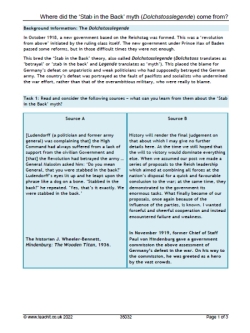Where did the 'Stab in the Back' myth (Dolchstosslegende) come from?

A source-based activity on the post-WWI conspiracy theory about Germany's defeat.
Students read brief background information about the origins of the 'Stab in the Back' myth then answer questions about two writtten sources and a visual source: an extract from a 1936 history book, a 1919 quotation from Hindenburg and an Austrian postcard also from 1919.
Background information: The Dolchstosslegende
In October 1918, a new government based on the Reichstag was formed. This was a ‘revolution from above’ initiated by the ruling class itself. The new government under Prince Max of Baden passed some reforms, but in those difficult times they were not enough.
This bred the ‘Stab in the Back’ theory, also called Dolchstosslegende (Dolchstoss translates as ‘betrayal’ or ‘stab in the back’ and Legende translates as ‘myth’). This placed the blame for Germany’s defeat on unpatriotic and weak politicians who had supposedly betrayed the German army. The country’s defeat was portrayed as the fault of pacifists and socialists who undermined the war effort, rather than that of the overambitious military, who were really to blame.
